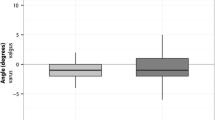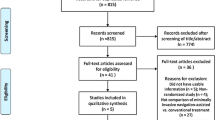Abstract
Patients desire less pain and faster recovery of range of knee motion after total knee arthroplasty (TKA). While minimal invasive surgery (MIS) TKA appears to meet these needs, concerns exist regarding component malpositioning. Navigation systems can reduce the incidence of component misalignment. The present prospective randomized study compared limited medial parapatellar (LMPP) and mini-midvastus (MMV) approaches in 30 patients who had bilateral simultaneous primary TKAs. Each patient underwent LMPP on one knee and MMV on the other. Both approaches were navigation-assisted. We primarily analyzed postoperative pain (using visual analog scores), range of knee motion, and hospital for special surgery (HSS) scores in the first 6 postoperative months (i.e., the early postoperative period), and secondarily analyzed perioperative parameters and radiographic outcomes. The LMPP and MMV approaches were found to be similar in terms of pain measured at postoperative 3 days, 1, 2 weeks, 1, 3, and 6 months (P = NS). Similarly, the 2 approaches were found to be similar in terms of range of motion measured at 1, 2 weeks, 1, 3, and 6 months (P = NS), and in terms of HSS scores measured at 1, 3, and 6 months (P = NS). There were also no differences between groups in terms of total blood loss, approach preferred by patients, and radiographic component positioning. The present study found that navigation-assisted MMV and navigation-assisted LMPP resulted in similar outcomes in terms of pain, ROM, HSS score, and radiologic outcomes over the first six postoperative months. We recommend the LMPP approach over the MMV approach in navigation-assisted MIS TKA because it is more familiar to surgeons and is easier to convert to the conventional approach where necessary.






Similar content being viewed by others
References
Altman DG, Schulz KF, Moher D, Egger M, Davidoff F, Elbourne D, Gotzsche PC, Lang T (2001) The revised CONSORT statement for reporting randomized trials: explanation and elaboration. Ann Intern Med 134:663–694
Benjamini Y, Hochberg Y (1995) Controlling the false discovery rate: a practical and powerful approach to multiple testing. J Roy Stat Soc Stat Soc Ser B (Methodological) 57:289–300
Bonutti PM, Mont MA, McMahon M, Ragland PS, Kester M (2004) Minimally invasive total knee arthroplasty. J Bone Joint Surg Am 86-A(Suppl 2):26–32
Chandrasekaran S, Molnar RB (2008) Minimally invasive imageless computer-navigated knee surgery: initial results. J Arthroplasty 23:441–445
Cooper RE Jr, Trinidad G, Buck WR (1999) Midvastus approach in total knee arthroplasty: a description and a cadaveric study determining the distance of the popliteal artery from the patellar margin of the incision. J Arthroplasty 14:505–508
Dalury DF, Dennis DA (2005) Mini-incision total knee arthroplasty can increase risk of component malalignment. Clin Orthop Relat Res 440:77–81
Ewald FC (1989) The Knee Society total knee arthroplasty roentgenographic evaluation and scoring system. Clin Orthop Relat Res 248:9–12
Haas SB, Manitta MA, Burdick P (2006) Minimally invasive total knee arthroplasty: the mini midvastus approach. Clin Orthop Relat Res 452:112–116
Han I, Seong SC, Lee S, Yoo JH, Lee MC (2008) Simultaneous bilateral MIS-TKA results in faster functional recovery. Clin Orthop Relat Res 466:1449–1453
Han SB, Nha KW, Yoon JR, Lee DH, Chae IJ (2008) The reliability of navigation-guided gap technique in total knee arthroplasty. Orthopedics 31(10 Suppl 1) [pii:orthosupersite.com/view.asp?rID=35542]
Holt G, Nunn T, Allen RA, Forrester AW, Gregori A (2008) Variation of the vastus medialis obliquus insertion and its relevance to minimally invasive total knee arthroplasty. J Arthroplasty 23:600–604
Karachalios T, Giotikas D, Roidis N, Poultsides L, Bargiotas K, Malizos KN (2008) Total knee replacement performed with either a mini-midvastus or a standard approach: a prospective randomised clinical and radiological trial. J Bone Joint Surg Br 90:584–591
Kim TK, Choi J, Shin KS, Chang CB, Seong SC (2008) Patients’ perspective on controversial issues in total knee arthroplasty. Knee Surg Sports Traumatol Arthrosc 16:297–304
King J, Stamper DL, Schaad DC, Leopold SS (2007) Minimally invasive total knee arthroplasty compared with traditional total knee arthroplasty. Assessment of the learning curve and the postoperative recuperative period. J Bone Joint Surg Am 89:1497–1503
Kolisek FR, Bonutti PM, Hozack WJ, Purtill J, Sharkey PF, Zelicof SB, Ragland PS, Kester M, Mont MA, Rothman RH (2007) Clinical experience using a minimally invasive surgical approach for total knee arthroplasty: early results of a prospective randomized study compared to a standard approach. J Arthroplasty 22:8–13
Laskin RS, Beksac B, Phongjunakorn A, Pittors K, Davis J, Shim JC, Pavlov H, Petersen M (2004) Minimally invasive total knee replacement through a mini-midvastus incision: an outcome study. Clin Orthop Relat Res 428:74–81
McAllister CM, Stepanian JD (2008) The impact of minimally invasive surgical techniques on early range of motion after primary total knee arthroplasty. J Arthroplasty 23:10–18
Pagnano MW, Meneghini RM, Trousdale RT (2006) Anatomy of the extensor mechanism in reference to quadriceps-sparing TKA. Clin Orthop Relat Res 452:102–105
Rosenberger RE, Hoser C, Quirbach S, Attal R, Hennerbichler A, Fink C (2008) Improved accuracy of component alignment with the implementation of image-free navigation in total knee arthroplasty. Knee Surg Sports Traumatol Arthrosc 16:249–257
Scuderi GR, Tenholder M, Capeci C (2004) Surgical approaches in mini-incision total knee arthroplasty. Clin Orthop Relat Res 428:61–67
Tenholder M, Clarke HD, Scuderi GR (2005) Minimal-incision total knee arthroplasty: the early clinical experience. Clin Orthop Relat Res 440:67–76
Watanabe N, Narita W, Namura T, Ito H, Nishimura T, Kubo T (2008) Anatomical assessment of the vastus medialis oblique muscle in patients with osteoarthritis of the knee. J Arthroplasty 23:287–292
Acknowledgments
No benefits in any form have been received or will be received from a commercial party related directly or indirectly to the subject of this article, nor have any funds been received in support of this study.
Author information
Authors and Affiliations
Corresponding author
Additional information
Research of this case was performed at Korea University Anam Hospital.
Rights and permissions
About this article
Cite this article
Lee, DH., Choi, J., Nha, KW. et al. No difference in early functional outcomes for mini-midvastus and limited medial parapatellar approaches in navigation-assisted total knee arthroplasty: a prospective randomized clinical trial. Knee Surg Sports Traumatol Arthrosc 19, 66–73 (2011). https://doi.org/10.1007/s00167-010-1130-4
Received:
Accepted:
Published:
Issue Date:
DOI: https://doi.org/10.1007/s00167-010-1130-4




